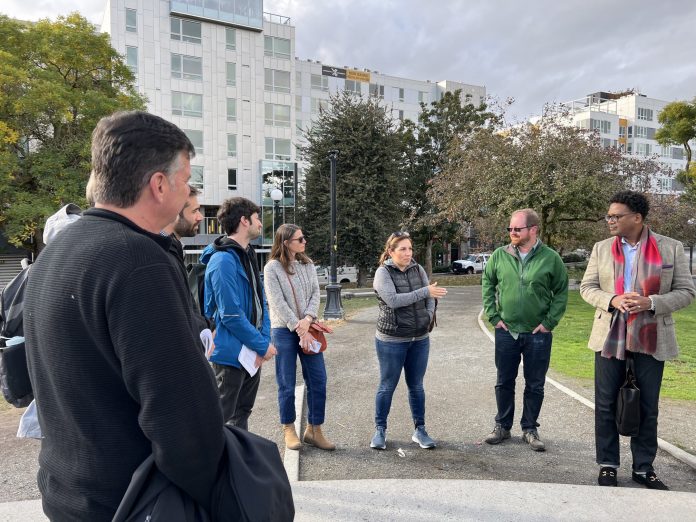
On Monday, urbanist advocates joined Councilmember Teresa Mosqueda in envisioning a pedestrianized “superblock” zone in the heart of Capitol Hill. Members of the Capitol Hill EcoDistrict, the Capitol Hill Business Alliance, local chapters of Seattle Neighborhood Greenways, and The Urbanist walked the proposed district along with Mosqueda, Seattle Department of Transportation (SDOT) Director Greg Spotts, and his senior staff.
“People here are really hungry for pedestrianization,” said tour guide Erin Fried, who is deputy director of Capitol Hill EcoDistrict and a boardmember at The Urbanist. The rest of the participants agreed.
Mosqueda, who proposed the idea in 2019, pledged to renew the quest and hinted at possibly securing funding to seed the effort in fall budget deliberations. For his part, Spotts appeared intrigued by the idea and expressed enthusiasm for improving safety and placemaking in the bustling district that serves a vibrant mix of residents, shoppers, commuters, students, and nightlife.
At its best, the busy corridor is a sidewalk ballet in the full sense Jane Jacobs intended. At its worst, it’s a crash waiting to happen: a car-choked mess with pedestrians spilling into the street from narrow sidewalks. A pedestrian superblock could accentuate the dance and open up opportunities for street cafes, greenery, and programming while essentially eliminating the risk of a serious collision.
The Capitol Hill proposal Mosqueda has floated would look something like what’s illustrated below. Diverters would keep car traffic on the perimeter formed by Broadway, E Union Street and 12th Avenue, leaving E Pike Street, 10th Avenue, and 11th Avenue pedestrianized within that perimeter, with allowances for freight deliveries and emergency vehicles. Pine Street would likely be partially pedestrianized but leave a way through for Route 11 bus traffic (at least barring a reroute).
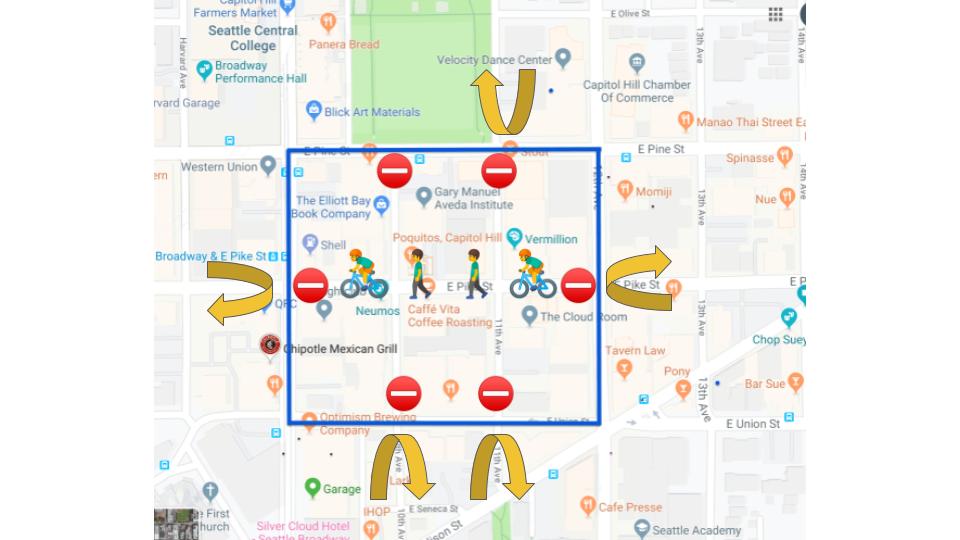
Eliminating through car traffic between 10th and 11th Avenues would allow a pedestrian plaza to form around the Black Lives Matter mural which runs down the middle of Pine Street, allowing the removal of the flexposts that detract from the artwork. The mural is a remnant and memorial to the Capitol Hill Organized Protest following George Floyd’s murder and the police retreat from the East Precinct.
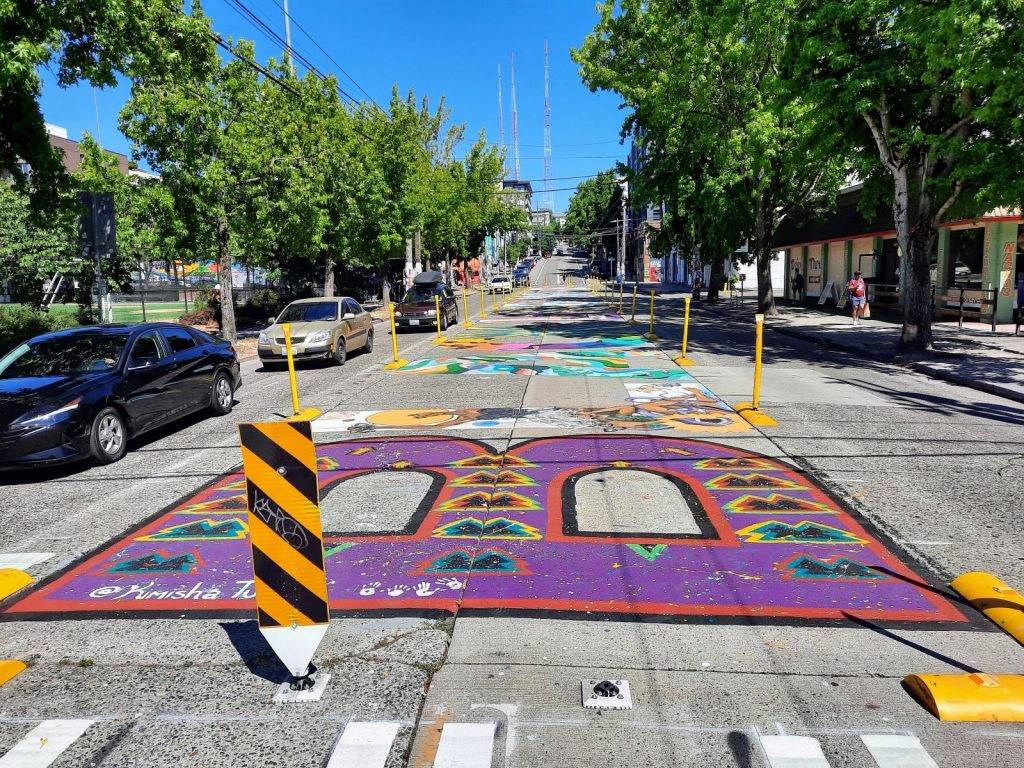
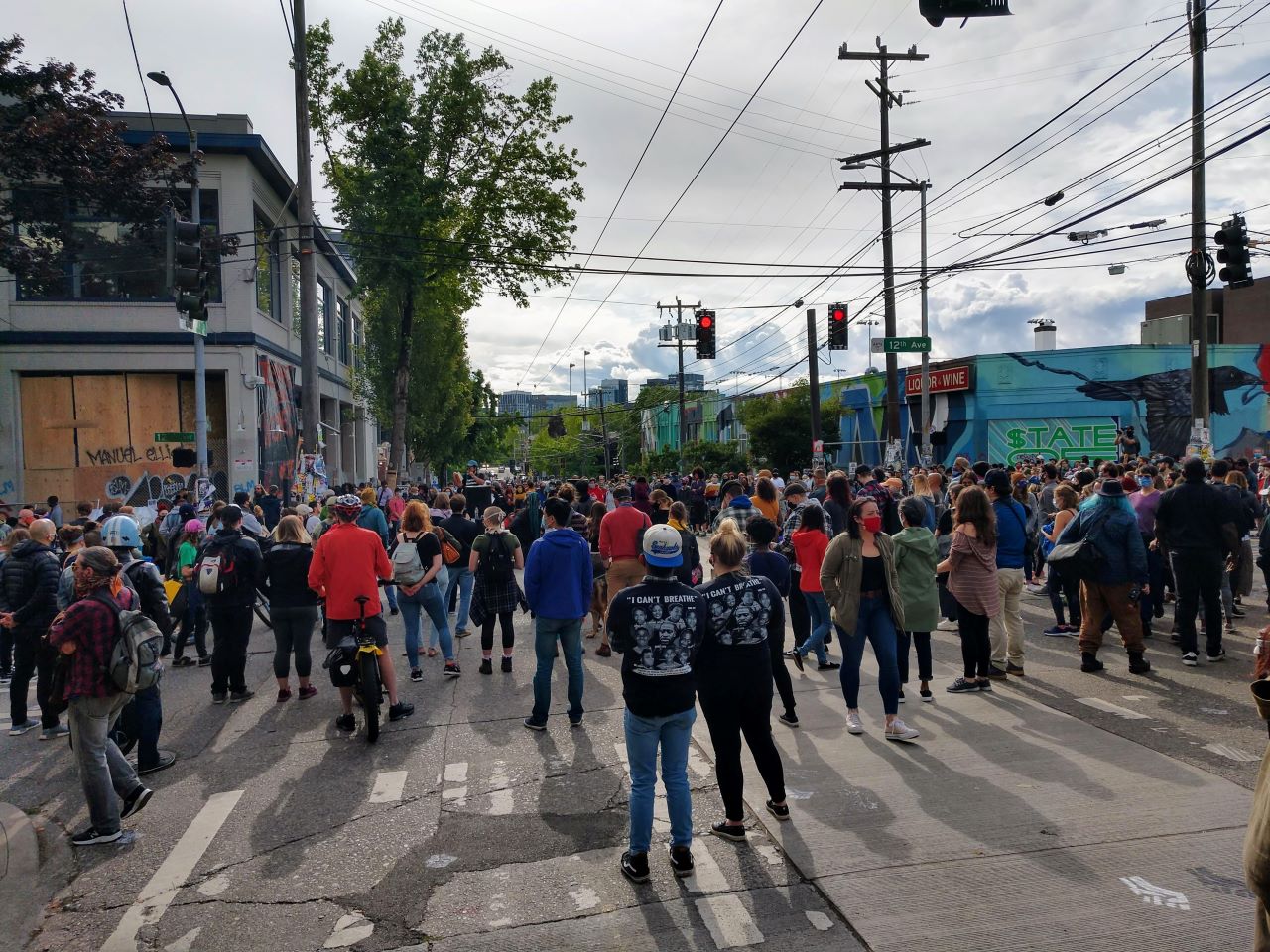
A pilot project and study dating back to 2015 already tested out Pike Street pedestrianization on a limited basis. Making the switch permanently could open up bigger opportunities, both day and night, and get pedestrians more accustomed to taking advantage of the extra street space for people walking, rolling, biking, and hanging out.
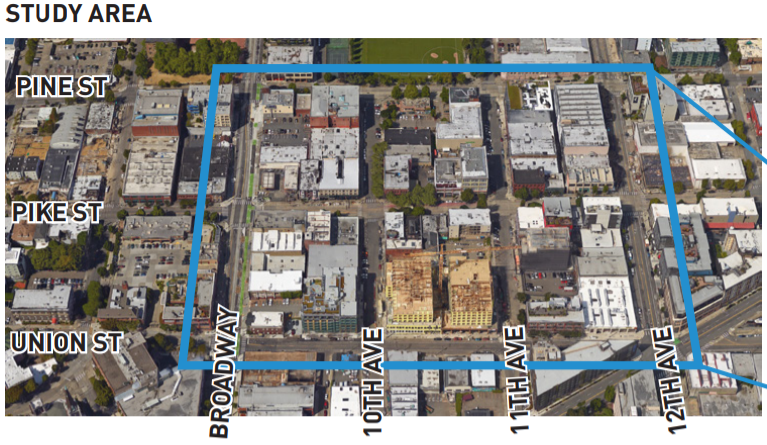
Since then, Capitol Hill’s light station station opened just to the north of the study area and quickly became one of the busiest in the city. Meanwhile, RapidRide G Line bus service on Madison Street is under construction and set to open in 2024, providing another rapid transit corridor to the south. The neighborhood adds hundreds more apartments every year. All told, Capitol Hill and First Hill together have added 7,600 homes since 2016, according to City data. This is a neighborhood primed for pedestrianization.
Barcelona has popularized the concept of the pedestrian superblock (or superille in Spanish) and implemented it widely throughout the city, even in the outskirts where a new district is forming at a former Mercedes-Benz factory. Many other cities have taken up the concept in Europe and Asia. In Seattle, we’re still working on getting the first pedestrian superblock off the ground, but the idea could spread rapidly once the first demonstration project proves out the concept locally and other neighborhoods seek their own.
Barcelona’s superblocks were inspiration for Mosqueda and found their way into her speeches during her first run for office and her 2017 Urbanist endorsement questionnaire: “I would also like to look at other cities like Barcelona–where they have created ‘Superblocks’—large nine square city blocks as an intentional urban mobility plan to reduce traffic and cut pollution. These Superblocks have led to greater social and cultural opportunities, slowed traffic, and allowed for more pedestrians in dense urban areas throughout their growing city. That is the type of innovation we can create in our city.”
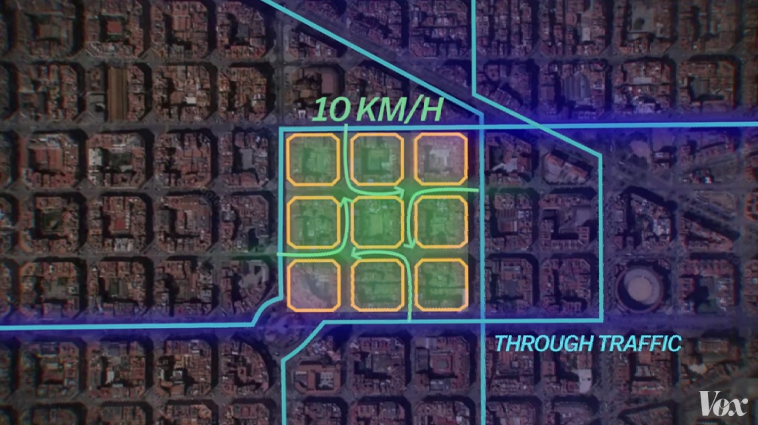
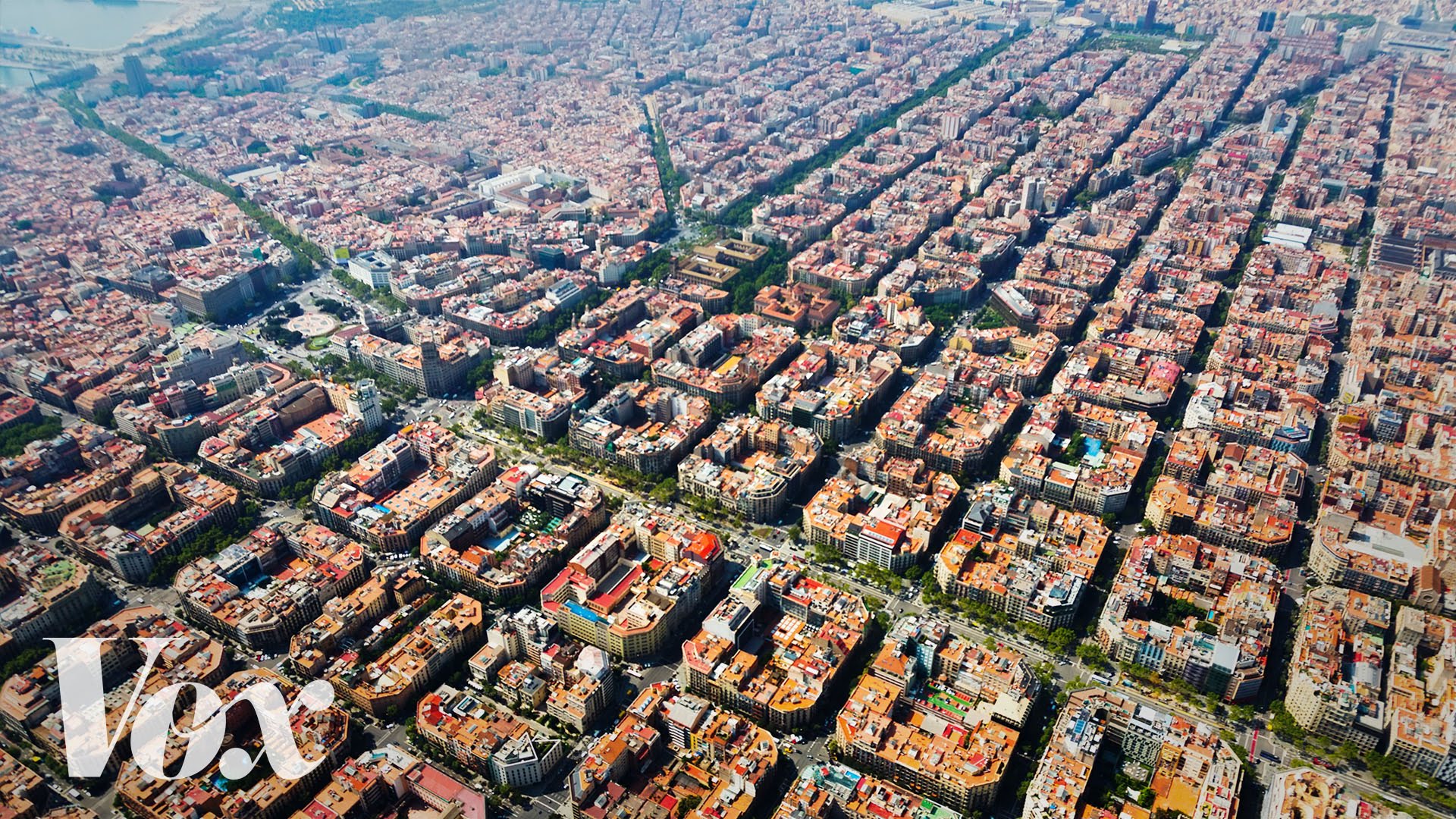
The pandemic interrupted plans to advance the Capitol Hill superblock sooner, but it appears a window of opportunity is opening up now. While not a proponent of a Capitol Hill superblock, former Mayor Jenny Durkan did rededicate some street space to pedestrians during the pandemic as part of her “Stay Healthy Streets” and “Keep Moving” park boulevard program. However, that program mostly hewed to existing neighborhood greenways and largely avoided the city’s densest neighborhoods and commercial districts. A Capitol Hill superblock would be a step to rectify that imbalance.
Monday’s tour did get into the weeds about how to make the superblock work well for everyone on a practical basis. Participants already had ideas about where the traffic diverters could go, establishing ridehailing drop-off zones on the perimeter, and how freight deliveries might work. Still, the idea is in a conceptual phase and it would take further study and outreach to stakeholders to arrive at a final plan that settles those questions for good.
The good news is that the Capitol Hill EcoDistrict has already been working with business owners and the Capitol Hill Business Alliance that represents many of them to understand their vision for the area. Capitol Hill Business Alliance Program Manager Ahi Martin-McSweeney attended the tour and also expressed optimism for the placemaking and business opportunities that the superblock could encourage.
Pride Month festivities every June already give Capitol Hill a taste of pedestrianization, with stages, drink gardens, and vendors spilling onto streets closed to cars. Crowds throng the streets to watch drag performances and musical acts or take part in open air dance clubs. That seems to have opened eyes among business owners that pedestrianization and street activation is good for business. The Capitol Hill Business Alliance is housed within the GSBA, which boasts of being the largest LGBTQ and allied chamber of commerce in North America. Applying the Pride treatment to the community every month of the year might not be such a tough sell.
Director Spotts’ enthusiasm for the idea and for engaging with advocates is another reason for optimism. Still new to the job and the city, Spotts seemed to relish being in the field and building relationships with stakeholders. His SDOT predecessors were also interested in making something like the superblock proposal happen, but it will take a considerable amount of work and steady support from both the Mayor and City Council to become a reality. It is possible all the ingredients are coming together. Or this could be just another meandering trip down Seattle Process lane.
Doug Trumm is publisher of The Urbanist. An Urbanist writer since 2015, he dreams of pedestrian streets, bus lanes, and a mass-timber building spree to end our housing crisis. He graduated from the Evans School of Public Policy and Governance at the University of Washington in 2019. He lives in Seattle's Fremont neighborhood and loves to explore the city by foot and by bike.


